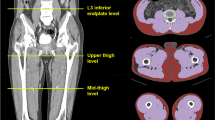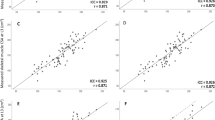Abstract
Objective
To evaluate the utility of multidetector computed tomography MDCT quantitative measurements in identifying sarcopenia.
Materials and methods
The clinical data and MDCT images of 64 patients of sarcopenia and 184 non-sarcopenic participants between October 2020 and January 2021were retrospectively analyzed. Propensity score matching was used to match the sarcopenic patients with the non-sarcopenic participants. Two radiologists independently measured the cross-sectional area (CSA) of skeletal muscle and intramuscular fat tissue and CT density of skeletal muscle at the middle L3 vertebral level on CT images of all participants. Intra-observer agreement was evaluated via intraclass correlation coefficients (ICC). A receiver operating characteristic (ROC) curve was built for each variable. Correlations between CT parameters and clinical data were assessed via Pearson or Spearman correlation coefficient.
Results
A total of 74 participants (mean age 72 ± 4 years, range 66–85 years; 38 men and 36 women) were included, comprising 37 sarcopenic patients and 37 non-sarcopenic participants. There were no significant intergroup differences regarding age, sex ratio, and body mass index (BMI) (P < 0.05). The CSA and density of skeletal muscle measured by two radiologists were reliable (ICC ≥ 0.75, P < 0.001). Compared with the sarcopenic group, the non-sarcopenic group had a significantly greater CSA and CT density of the total skeletal muscle (TSM) and paraspinal skeletal muscle (PSM) and skeletal muscle index at L3 level (L3 SMI) (P < 0.05). The fat infiltration ratio (FIR) of TSM, PSM, and psoas muscle was significantly higher in the sarcopenic group than that in non-sarcopenic participants (P < 0.05). ROC curve analysis showed the PSM FIR + PSM CT density (PSM D) had the best predictive value for sarcopenia (AUC = 0.836). The PSM FIR and age were moderately positively correlated (r = 0.410, P < 0.001).
Conclusion
Fat infiltration of skeletal muscle had better predictive value than L3 SMI in the diagnosis of sarcopenic. The PSM FIR + PSMD had the best predictive value for sarcopenia, which was moderately positively correlated with age.




Similar content being viewed by others
References
Lee K, Shin Y, Huh J, et al. Recent issues on body composition imaging for sarcopenia evaluation [J]. Korean J Radiol. 2019;220(2):205–17.
Pinto Dos Santos D, Kloeckner R, Koch S, et al. Sarcopenia as prognostic factor for survival after orthotopic liver transplantation[J]. Eur J Gastroenterol Hepatol. 2020;32(5):626–35.
Onishi S, Tajika M, Tanaka T, et al. Prognostic significance of sarcopenia in patients with unresectable advanced esophageal cancer. J Clin Med. 2019;8(10):1647.
Dong Q. Fully-automated segmentation of muscle measurement on CT in detecting central sarcopenia: a trend of standardization. Acad Radiol. 2020;27(3):321–2.
Taguchi S, Akamatsu N, Nakagawa T, et al. Sarcopenia evaluated using the skeletal muscle index is a significant prognostic factor for metastatic urothelial carcinoma. Clin Genitourin Cancer. 2016;14(3):237–43.
Schweitzer L, Geisler C, Pourhassan M, et al. What is the best reference site for a single MRI slice to assess whole-body skeletal muscle and adipose tissue volumes in healthy adults? Am J Clin Nutr. 2015;102(1):58–65.
Prado CM, Lieffers JR, McCargar LJ, et al. Prevalence and clinical implications of sarcopenic obesity in patients with solid tumors of the respiratory and gastrointestinal tracts: a population-based study. Lancet Oncol. 2008;9(7):629–35.
Van Rijssen LB, Van Huijgevoort NC, Coelen RJ, et al. Skeletal muscle quality is associated with worse survival after pancreatoduodenectomy for periampullary, nonpancreatic cancer. Ann Surg Oncol. 2017;24(1):272–80.
Iritani S, Imai K, Takai K, et al. Skeletal muscle depletion is an independent prognostic factor for hepatocellular carcinoma. J Gastroenterol. 2015;50(3):323–32.
Nakamura N, Hara T, Shibata Y, et al. Sarcopenia is an independent prognostic factor in male patients with diffuse large B-cell lymphoma. Ann Hematol. 2015;94(12):2043–53.
Cho KM, Park HY, Oh DY, et al. Skeletal muscle depletion predicts survival of patients with advanced biliary tract cancer undergoing palliative chemotherapy. Oncotarget. 2017;8(45):79441–52.
Choi Y, Oh DY, Kim TY, et al. Skeletal muscle depletion predicts the prognosis of patients with advanced pancreatic cancer undergoing palliative chemotherapy, independent of body mass index. PLoS One. 2015;10(10):e0139749.
Camastra S, Vitali A, Anselmino M, et al. Muscle and adipose tissue morphology, insulin sensitivity and beta-cell function in diabetic and nondiabetic obese patients: effects of bariatric surgery[J]. Sci Rep. 2017;7(1):9007.
Jankowski CM, Gozansky WS, Van Pelt RE, et al. Relative contributions of adiposity and muscularity to physical function in community-dwelling older adults[J]. Obesity (Silver Spring). 2008;16(5):1039–44.
Hamrick MW, McGee-Lawrence ME, Frechette DM. Fatty infiltration of skeletal muscle: mechanisms and comparisons with bone marrow adiposity[J]. Front Endocrinol (Lausanne). 2016;7:69.
Goodpaster BH, Kelly DE, Thaete FL, et al. Skeletal muscle attenuation determined by computed tomography is associated with skeletal muscle lipid content[J]. J Appl Physiol (1985). 2000;89(1):104–10.
Chen LK, Woo J, Assantachai P, et al. Asian working group for sarcopenia:2019 consensus update on sarcopenia diagnosis and treatment. J Am Med Dir Assoc. 2020;21(3):300–7.
Sinelnikov A, Qu CX, Fetzer D, et al. Measurement of skeletal muscle area: comparison of CT and MR imaging. Eur J Radiol. 2016;85(10):1716–21.
Beattie K, Davison MJ, Noseworthy M, et al. Quantifying fat and lean muscle in the lower legs of women with knee osteoarthritis using two different MRI systems. Rheumatol Int. 2016;36(6):855–62.
Antoun S, Lanoy E, Albiges-Sauvin L, et al. Clinical implications of body composition assessment by computed tomography in metastatic renal cell carcinoma. Expert Rev Anticancer Ther. 2014;14(3):279–88.
Khan AI, Reiter DA, Sekhar A, et al. MRI quantitation of abdominal skeletal muscle correlates with CT-based analysis: implications for sarcopenia measurement. Appl Physiol Nutr Metab. 2019;44(8):814–9.
Prasetyo M, Nindita N, Murdana IN, et al. Computed tomography evaluation of fat infiltration ratio of the multifidus muscle in chronic low back pain patients. Eur J Radiol Open. 2020;7:100293.
Albano D, Messina C, Vitale J, et al. Imaging of sarcopenia: old evidence and new insights. Eur Radiol. 2020;30(4):2199–208.
Cruz-Jentoft AJ, Baeyens JP, Bauer JM, et al. Sarcopenia: European consensus on definition and diagnosis: report of the European Working Group on sarcopenia in older people. Age Ageing. 2010;39(4):412–23.
Brioche T, Pagano AF, Py G, et al. Muscle wasting and aging: experimental models, fatty infiltrations, and prevention. Mol Aspects Med. 2016;50:56–87.
Cruz-Jentoft AJ, Bahat G, Bauer J, et al. Sarcopenia: revised European consensus on definition and diagnosis. Age Ageing. 2019;48(1):16–31.
Kalichman L, Carmeli E, Been E. The association between imaging parameters of the paraspinal muscles, spinal degeneration, and low back pain. Biomed Res Int. 2017;2017:2562957.
Ranson CA, Burnett AF, Kerslake R, et al. An investigation into the use of MR imaging to determine the functional cross-sectional area of lumbar paraspinal muscles. Eur Spine J. 2006;15:764–73.
Hicks GE, Simonsick EM, Harris TB, et al. Cross-sectional associations between trunk muscle composition, back pain, and physical function in the health, aging and body composition study. J Gerontol A Biol Sci Med Sci. 2005;60(7):882–7.
Kim WJ, Kim KJ, Song DG, et al. Sarcopenia and back muscle degeneration as risk factors for back pain: a comparative study. Asian Spine J. 2020;14(3):364–72.
Kalichman L, Hodges P, Li L, et al. Changes in paraspinal muscles and their association with low back pain and spinal degeneration: CT study. Eur Spine J. 2010;19(7):1136–44.
Kalichman L, Klindukhov A, Li L, et al. Indices of paraspinal muscles degeneration: reliability and association with facet joint osteoarthritis: feasibility study. Clin Spine Surg. 2016;29(9):465–70.
Termote JL, Baert A, Crolla D, et al. Computed tomography of the normal and pathologic muscular system. Radiology. 1980;137(2):439–44.
Roubenoff R. Sarcopenia and its implications for the elderly. Eur J Clin Nutr. 2000;54(Supp. 3):S40-47.
Jones DA, Rutherford OM, Parker DF. Physiological changes in skeletal muscle as a results of strength training. Q J Exp Physiol. 1989;74:233–56.
Goodpaster BH, Kelly DE, Thaete FL, et al. Skeletal muscle attenuation determined by computed tomography is associated with skeletal muscle lipid content[J]. J Appl Physiol (1985). 2000;89(1):104–10.
Sebro R, O’Brien L, Torriani M, et al. Assessment of trunk muscle density using CT and its association with degenerative disc and facet joint disease of the lumbar spine. Skeletal Radiol. 2016;45(9):1221–6.
Takayama K, Kita T, Nakamura H, et al. New predictive index for lumbar paraspinal muscle degeneration associated with aging. Spine (Phila Pa 1976). 2016;41(2):E84-90.
Roberto V, Gabriella M, Franzin C, et al. The origin of intermuscular adipose tissue and its pathophysiological implications. Am J Physiol Endocrinol Metab. 2009;297(5):E987-998.
Morales PE, Bucarey JL, Espinosa A. Muscle lipid metabolism: role of lipid droplets and perilipins. J Diabetes Res. 2017;2017:1789395.
Parkkola R, Kormano M. Lumbar disc and back muscle degeneration on MRI: correlation to age and body mass. J Spinal Disord. 1992;5(1):86–92.
Kjaer P, Bendix T, Sorensen JS, et al. Are MRI-defined fat infiltration in the multifidus muscles associated with low back pain? BMC Med. 2007;5:2.
Funding
This study was supported by Medical Science Research Project of Hebei Province (no. 20211544).
Author information
Authors and Affiliations
Corresponding author
Ethics declarations
Ethics approval
Approval from the Institutional Review Board was obtained, and in keeping with the policies for a retrospective review, informed consent was not required.
Conflict of interest
The authors declare no competing interests.
Additional information
Publisher’s note
Springer Nature remains neutral with regard to jurisdictional claims in published maps and institutional affiliations.
Rights and permissions
About this article
Cite this article
Zuo, YQ., Gao, ZH., Wang, Z. et al. Utility of multidetector computed tomography quantitative measurements in identifying sarcopenia: a propensity score matched study. Skeletal Radiol 51, 1303–1312 (2022). https://doi.org/10.1007/s00256-021-03953-y
Received:
Revised:
Accepted:
Published:
Issue Date:
DOI: https://doi.org/10.1007/s00256-021-03953-y




